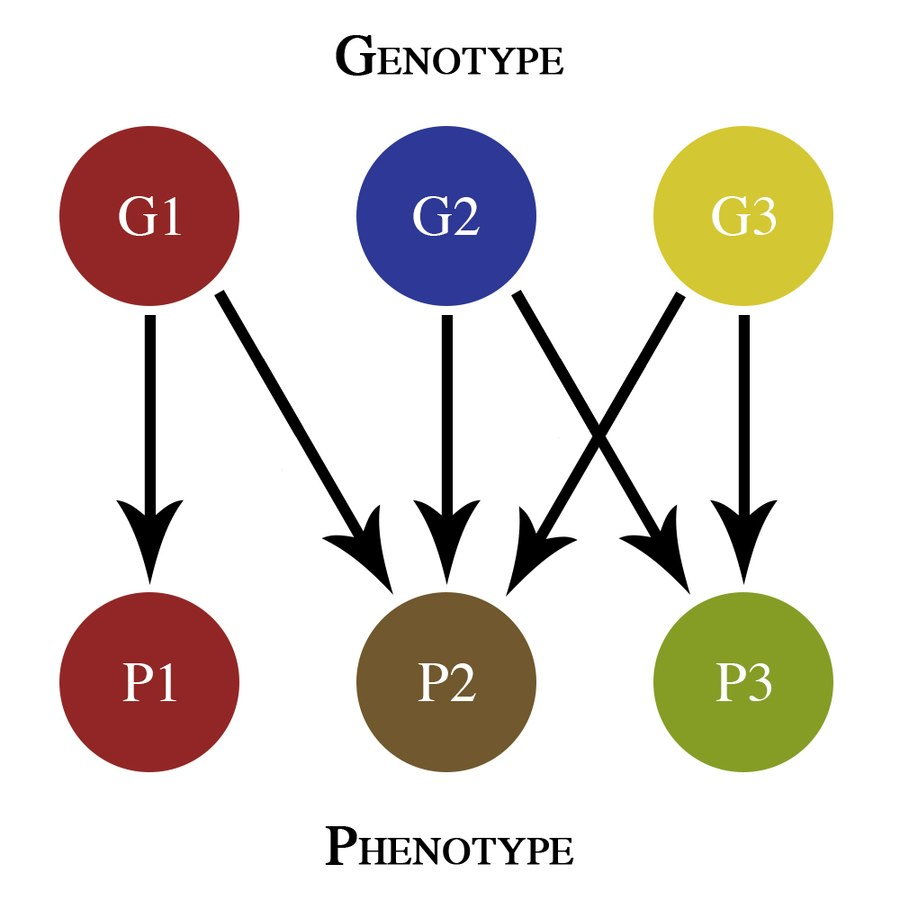Answer
384.9k+ views
Hint: There are several genes found in nature that influence two or more seemingly unrelated phenotypic traits. Due to this reason, mutation in one of these genes may affect several traits simultaneously. Sometimes the effects of such mutations can be good, while on other occasions, they might be fatal to the organism.
Complete answer:
The phenomenon where a single gene influences two or more seemingly unrelated phenotypic traits is called pleiotropy. Such a gene that shows multiple phenotypic expressions is known as a pleiotropic gene.

The term pleiotropy is derived from the Greek word “pleio”, which means “many”, and “tropic”, which means “affecting”.
Examples of pleiotropy:
In Drosophila, the gene that controls white eye mutation is also responsible for depigmentation of body parts.
Amino acid tyrosine is needed for general protein synthesis and is also a precursor for many neurotransmitters (e.g., norepinephrine, dopamine), the pigment melanin, and thyroxine hormone.
Hence, the correct answer is option (D).
Additional information:
During Gregor Mendel’s study of pea plants, he observed that plants with coloured seed coats always had coloured leaf axils and coloured flowers. He also noticed that pea plants with colourless seed coats always had white flowers and no pigmentation on their axils. This means that in Mendel’s pea plants, seed coat colour was always associated with flower and axle colours. Today, we know that these observations were the result of pleiotropy. Here in this case, the seed coat colour gene was not only responsible for seed coat colour, but also for flower and axle pigmentation.
Note: Important things to remember-
• Pleiotropy is often confused with polygenic traits. While in pleiotropy, a single gene affects multiple phenotypic traits, polygeny is the phenomenon in which multiple genes converge to result in a single phenotype.
• The term pleiotropy was formally introduced by the German geneticist Ludwig Plate, in the year 1910.
Complete answer:
The phenomenon where a single gene influences two or more seemingly unrelated phenotypic traits is called pleiotropy. Such a gene that shows multiple phenotypic expressions is known as a pleiotropic gene.

The term pleiotropy is derived from the Greek word “pleio”, which means “many”, and “tropic”, which means “affecting”.
Examples of pleiotropy:
In Drosophila, the gene that controls white eye mutation is also responsible for depigmentation of body parts.
Amino acid tyrosine is needed for general protein synthesis and is also a precursor for many neurotransmitters (e.g., norepinephrine, dopamine), the pigment melanin, and thyroxine hormone.
Hence, the correct answer is option (D).
Additional information:
During Gregor Mendel’s study of pea plants, he observed that plants with coloured seed coats always had coloured leaf axils and coloured flowers. He also noticed that pea plants with colourless seed coats always had white flowers and no pigmentation on their axils. This means that in Mendel’s pea plants, seed coat colour was always associated with flower and axle colours. Today, we know that these observations were the result of pleiotropy. Here in this case, the seed coat colour gene was not only responsible for seed coat colour, but also for flower and axle pigmentation.
Note: Important things to remember-
• Pleiotropy is often confused with polygenic traits. While in pleiotropy, a single gene affects multiple phenotypic traits, polygeny is the phenomenon in which multiple genes converge to result in a single phenotype.
• The term pleiotropy was formally introduced by the German geneticist Ludwig Plate, in the year 1910.
Recently Updated Pages
Basicity of sulphurous acid and sulphuric acid are

What is the stopping potential when the metal with class 12 physics JEE_Main

The momentum of a photon is 2 times 10 16gm cmsec Its class 12 physics JEE_Main

Using the following information to help you answer class 12 chemistry CBSE

Which of the following would not be a valid reason class 11 biology CBSE

Why should electric field lines never cross each other class 12 physics CBSE

Trending doubts
Difference Between Plant Cell and Animal Cell

Difference between Prokaryotic cell and Eukaryotic class 11 biology CBSE

Fill the blanks with the suitable prepositions 1 The class 9 english CBSE

Change the following sentences into negative and interrogative class 10 english CBSE

Give 10 examples for herbs , shrubs , climbers , creepers

Fill the blanks with proper collective nouns 1 A of class 10 english CBSE

Select the word that is correctly spelled a Twelveth class 10 english CBSE

How fast is 60 miles per hour in kilometres per ho class 10 maths CBSE

What organs are located on the left side of your body class 11 biology CBSE



